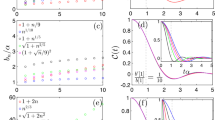Abstract
We analyze the origin of quantum randomness within the framework of a completely deterministic theory of particle motion—Bohmian mechanics. We show that a universe governed by this mechanics evolves in such a way as to give rise to the appearance of randomness, with empirical distributions in agreement with the predictions of the quantum formalism. Crucial ingredients in our analysis are the concept of the effective wave function of a subsystem and that of a random system. The latter is a notion of interest in its own right and is relevant to any discussion of the role of probability in a deterministic universe.
Similar content being viewed by others
References
J. S. Bell, “Beables for quantum field theory,” CERN-TH 4035/84, reprinted in Ref. 2.
J. S. Bell,Speakable and Unspeakable in Quantum Mechanics (Cambridge University Press, Cambridge, 1987).
J. S. Bell, “Against measurement,”Physics World 3, 33–40 (1990).
K. Berndl, Dotoral Thesis, Universität München, in preparation.
D. Bohm, “A suggested interpretation of the quantum theory in terms of ‘hidden variables’,”Phys. Rev. 85, 166–193 (1952).
D. Bohm, B. J. Hiley, and P. N. Kaloyerou, “An ontological basis for quantum theory. II A causal interpretation of quantum fields,”Phys. Rep. 144, 349–375 (1987).
D. Dürr, S. Goldstein, and N. Zanghí, “Quantum equilibrium and the origin of absolute uncertainty,”J. Stat. Phys. 67, 843–907 (1992).
D. Dürr, S. Goldstein, and N. Zanghí, “On a realistic theory for quantum physics,” inStochastic Processes, Geometry and Physics, S. Albeverio, G. Casati, U. Cattaneo, D. Merlini, and R. Mortesi, eds. (World Scientific, Singapore, 1990), pp. 374–391.
M. Daumer, D. Dürr, S. Goldstein, and N. Zanghí, “On the role of operators in quantum theory,” in preparation.
H. Everett, “‘Relative state’ formulation of quantum mechanics,”Rev. Mod. Phys. 29, 454–462 (1957).
M. Gell-Mann and J. B. Hartle, “Quantum mechanics in the light of quantum cosmology,” inComplexity, Entropy, and the Physics of Information, W. Zurek, ed. (Adison-Wesley, Reading, Massachusetts, 1990), pp. 425–458.
G. C. Ghirardi, A. Rimini, and T. Weber, Unified dynamics for microscopic and macroscopic systems,”Phys. Rev. D 34, 470–491 (1986).
W. Heisenberg,Physics and Beyond (Harper & Row, New York, 1971), p. 63.
N. S. Krylov,Works on the Foundations of Statistical Mechanics (Princeton University Press, Princeton, 1979).
R. Penrose,The Emperor's New Mind (Oxford University Press, New York, 1989).
Author information
Authors and Affiliations
Additional information
Research supported in part by NSF Grant DMS-9105661.
Rights and permissions
About this article
Cite this article
Dürr, D., Goldstein, S. & Zanghí, N. A global equilibrium as the foundation of quantum randomness. Found Phys 23, 721–738 (1993). https://doi.org/10.1007/BF01883806
Received:
Issue Date:
DOI: https://doi.org/10.1007/BF01883806




